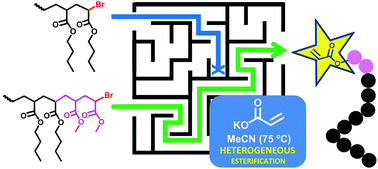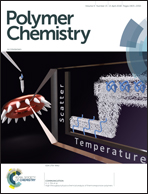Acrylate-macromonomers and telechelics of PBA by merging biphasic SET-LRP of BA, chain extension with MA and biphasic esterification
Abstract
Single electron transfer-living radical polymerization (SET-LRP) provides excellent control over polymer chain-end functionality. The chain ends of poly(butyl acrylate) (PBA), prepared by biphasic SET-LRP in an acetone/water mixture using a non-activated Cu(0) wire/TREN/Cu(II)X2 catalytic system, could not be reacted quantitatively using a biphasic reaction mixture of potassium acrylate (KA) in acetonitrile at 75 °C. This procedure was previously successfully applied to poly(methyl acrylate). The PBA chain ends showed lower reactivity due to their higher hydrophobicity and sterically hindered nature. However, the chain extension of α-bromo and α,ω-dibromo PBA with a few monomeric units of MA dramatically changed the reactivity of PBA. Thus, acrylate-functionalized macromonomers and telechelics based on PBA could be successfully prepared by merging biphasic SET-LRP, chain extension with MA and heterogeneous esterification with KA in acetonitrile at 75 °C. This three step methodology, that can be simplified by carrying out two or even three steps in one pot, is expected to become a general route for the preparation of acrylate-functionalized polyacrylates derived from monomers with hydrophobic and sterically hindered substituents.

- This article is part of the themed collection: Frontiers in Supramolecular and Macromolecular Science symposia


 Please wait while we load your content...
Please wait while we load your content...
